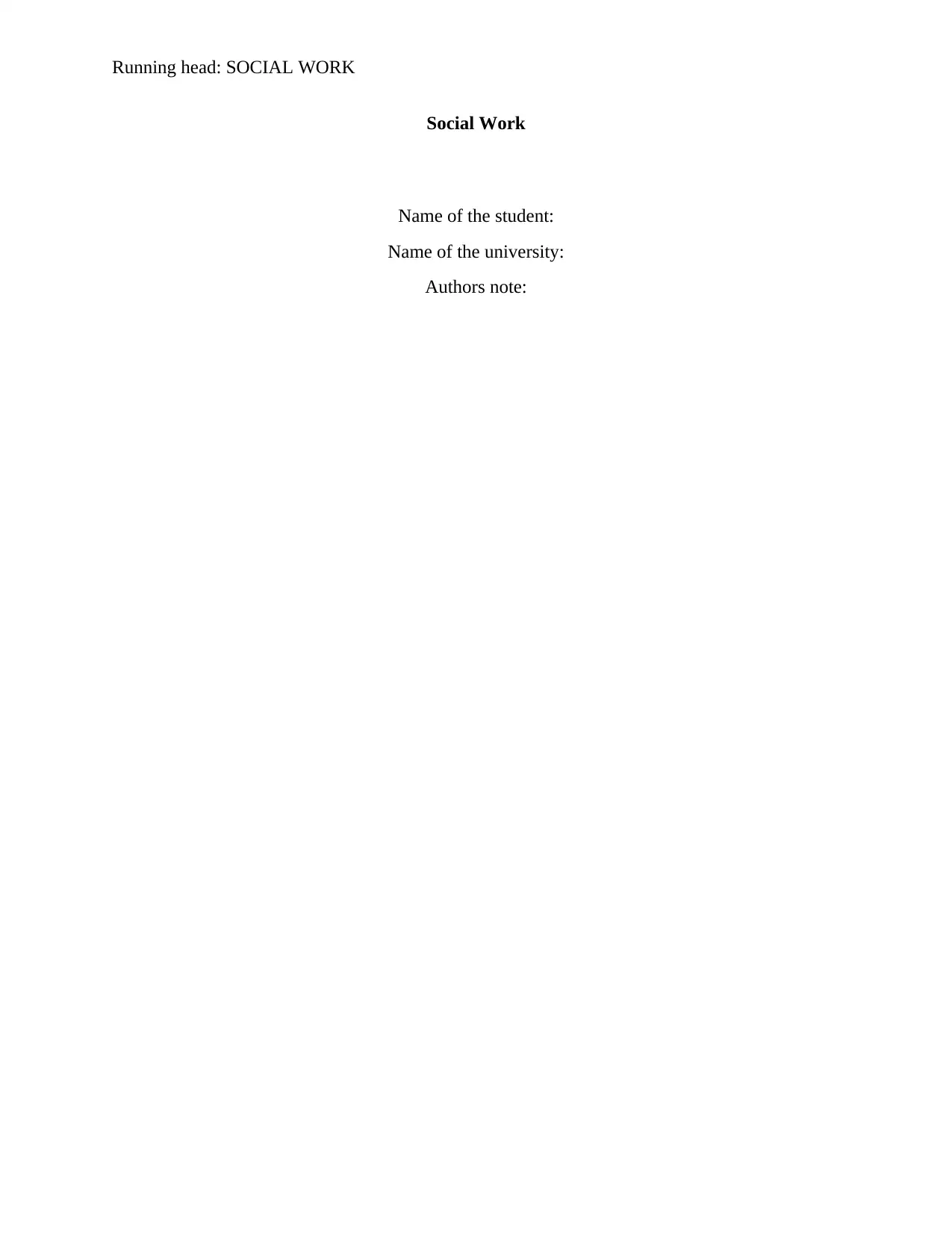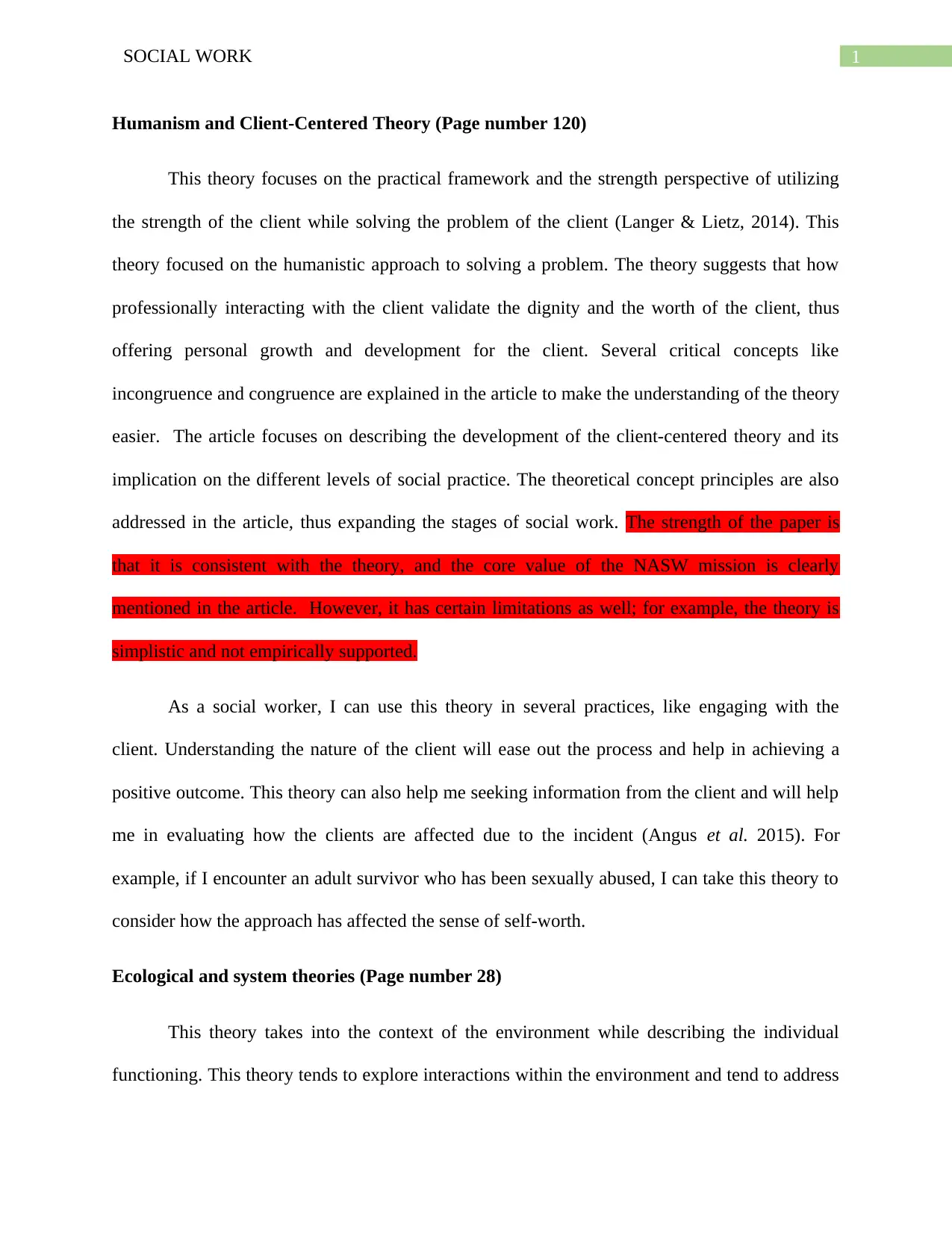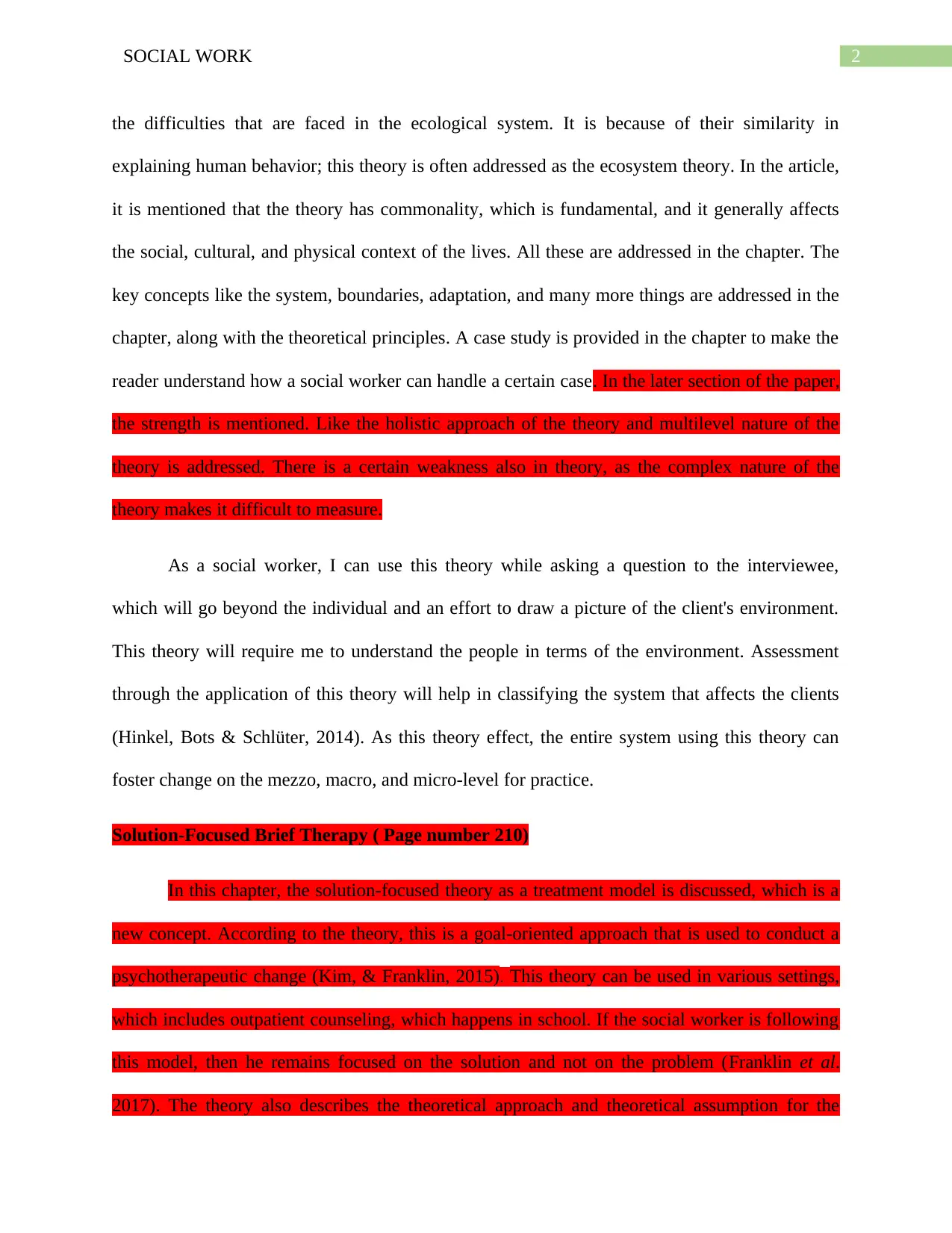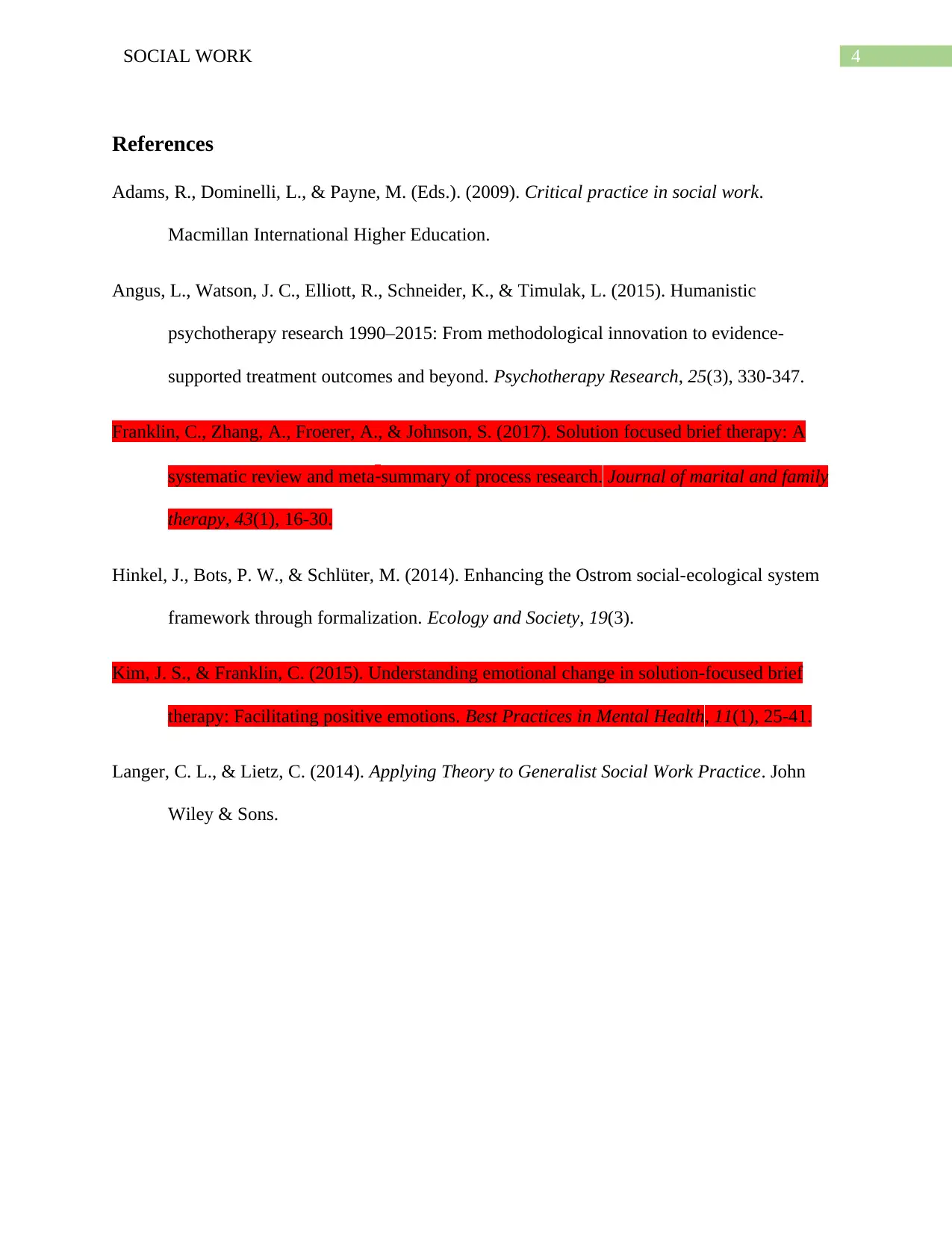Social Work Theories: Humanism, Ecological, and Solution-Focused
VerifiedAdded on 2022/08/19
|5
|1137
|8
Report
AI Summary
This report analyzes three key social work theories: Humanism and Client-Centered Theory, Ecological and System Theories, and Solution-Focused Brief Therapy. The report examines the core principles, strengths, and limitations of each theory, providing practical applications for social work practice. The Humanistic approach emphasizes client strengths and personal growth, while Ecological theory considers the environment's impact on individuals. Solution-Focused Brief Therapy focuses on goal-oriented solutions rather than dwelling on problems. The report includes references to relevant literature and discusses how these theories can be applied in various social work settings, such as engaging with clients, assessing their environments, and facilitating positive outcomes. The report also touches on the importance of cross-cultural practice and the need for critical interrogation in this area.

Running head: SOCIAL WORK
Social Work
Name of the student:
Name of the university:
Authors note:
Social Work
Name of the student:
Name of the university:
Authors note:
Paraphrase This Document
Need a fresh take? Get an instant paraphrase of this document with our AI Paraphraser

1SOCIAL WORK
Humanism and Client-Centered Theory (Page number 120)
This theory focuses on the practical framework and the strength perspective of utilizing
the strength of the client while solving the problem of the client (Langer & Lietz, 2014). This
theory focused on the humanistic approach to solving a problem. The theory suggests that how
professionally interacting with the client validate the dignity and the worth of the client, thus
offering personal growth and development for the client. Several critical concepts like
incongruence and congruence are explained in the article to make the understanding of the theory
easier. The article focuses on describing the development of the client-centered theory and its
implication on the different levels of social practice. The theoretical concept principles are also
addressed in the article, thus expanding the stages of social work. The strength of the paper is
that it is consistent with the theory, and the core value of the NASW mission is clearly
mentioned in the article. However, it has certain limitations as well; for example, the theory is
simplistic and not empirically supported.
As a social worker, I can use this theory in several practices, like engaging with the
client. Understanding the nature of the client will ease out the process and help in achieving a
positive outcome. This theory can also help me seeking information from the client and will help
me in evaluating how the clients are affected due to the incident (Angus et al. 2015). For
example, if I encounter an adult survivor who has been sexually abused, I can take this theory to
consider how the approach has affected the sense of self-worth.
Ecological and system theories (Page number 28)
This theory takes into the context of the environment while describing the individual
functioning. This theory tends to explore interactions within the environment and tend to address
Humanism and Client-Centered Theory (Page number 120)
This theory focuses on the practical framework and the strength perspective of utilizing
the strength of the client while solving the problem of the client (Langer & Lietz, 2014). This
theory focused on the humanistic approach to solving a problem. The theory suggests that how
professionally interacting with the client validate the dignity and the worth of the client, thus
offering personal growth and development for the client. Several critical concepts like
incongruence and congruence are explained in the article to make the understanding of the theory
easier. The article focuses on describing the development of the client-centered theory and its
implication on the different levels of social practice. The theoretical concept principles are also
addressed in the article, thus expanding the stages of social work. The strength of the paper is
that it is consistent with the theory, and the core value of the NASW mission is clearly
mentioned in the article. However, it has certain limitations as well; for example, the theory is
simplistic and not empirically supported.
As a social worker, I can use this theory in several practices, like engaging with the
client. Understanding the nature of the client will ease out the process and help in achieving a
positive outcome. This theory can also help me seeking information from the client and will help
me in evaluating how the clients are affected due to the incident (Angus et al. 2015). For
example, if I encounter an adult survivor who has been sexually abused, I can take this theory to
consider how the approach has affected the sense of self-worth.
Ecological and system theories (Page number 28)
This theory takes into the context of the environment while describing the individual
functioning. This theory tends to explore interactions within the environment and tend to address

2SOCIAL WORK
the difficulties that are faced in the ecological system. It is because of their similarity in
explaining human behavior; this theory is often addressed as the ecosystem theory. In the article,
it is mentioned that the theory has commonality, which is fundamental, and it generally affects
the social, cultural, and physical context of the lives. All these are addressed in the chapter. The
key concepts like the system, boundaries, adaptation, and many more things are addressed in the
chapter, along with the theoretical principles. A case study is provided in the chapter to make the
reader understand how a social worker can handle a certain case. In the later section of the paper,
the strength is mentioned. Like the holistic approach of the theory and multilevel nature of the
theory is addressed. There is a certain weakness also in theory, as the complex nature of the
theory makes it difficult to measure.
As a social worker, I can use this theory while asking a question to the interviewee,
which will go beyond the individual and an effort to draw a picture of the client's environment.
This theory will require me to understand the people in terms of the environment. Assessment
through the application of this theory will help in classifying the system that affects the clients
(Hinkel, Bots & Schlüter, 2014). As this theory effect, the entire system using this theory can
foster change on the mezzo, macro, and micro-level for practice.
Solution-Focused Brief Therapy ( Page number 210)
In this chapter, the solution-focused theory as a treatment model is discussed, which is a
new concept. According to the theory, this is a goal-oriented approach that is used to conduct a
psychotherapeutic change (Kim, & Franklin, 2015). This theory can be used in various settings,
which includes outpatient counseling, which happens in school. If the social worker is following
this model, then he remains focused on the solution and not on the problem (Franklin et al.
2017). The theory also describes the theoretical approach and theoretical assumption for the
the difficulties that are faced in the ecological system. It is because of their similarity in
explaining human behavior; this theory is often addressed as the ecosystem theory. In the article,
it is mentioned that the theory has commonality, which is fundamental, and it generally affects
the social, cultural, and physical context of the lives. All these are addressed in the chapter. The
key concepts like the system, boundaries, adaptation, and many more things are addressed in the
chapter, along with the theoretical principles. A case study is provided in the chapter to make the
reader understand how a social worker can handle a certain case. In the later section of the paper,
the strength is mentioned. Like the holistic approach of the theory and multilevel nature of the
theory is addressed. There is a certain weakness also in theory, as the complex nature of the
theory makes it difficult to measure.
As a social worker, I can use this theory while asking a question to the interviewee,
which will go beyond the individual and an effort to draw a picture of the client's environment.
This theory will require me to understand the people in terms of the environment. Assessment
through the application of this theory will help in classifying the system that affects the clients
(Hinkel, Bots & Schlüter, 2014). As this theory effect, the entire system using this theory can
foster change on the mezzo, macro, and micro-level for practice.
Solution-Focused Brief Therapy ( Page number 210)
In this chapter, the solution-focused theory as a treatment model is discussed, which is a
new concept. According to the theory, this is a goal-oriented approach that is used to conduct a
psychotherapeutic change (Kim, & Franklin, 2015). This theory can be used in various settings,
which includes outpatient counseling, which happens in school. If the social worker is following
this model, then he remains focused on the solution and not on the problem (Franklin et al.
2017). The theory also describes the theoretical approach and theoretical assumption for the
⊘ This is a preview!⊘
Do you want full access?
Subscribe today to unlock all pages.

Trusted by 1+ million students worldwide

3SOCIAL WORK
study. There are certain principles that are associated with the SBFT, which include the
uniqueness of the client, how different people process certain exceptions like the problem would
be likely to exist in the future, there are other principles as well, which is discussed in the
chapter. Strength is there in the article, which has compatibility with the social work values and
in the involuntary cases as well and how an exception to the problem always exists. The
disadvantage of the study is that there is a lack of empirical work in the study, which has a
certain inherent methodological limitation as well.
This theory can be used in application as well by the sociologist. If a client comes to me
with a problem, I can use this theory to provide a solution rather than pondering on the problem
study. There are certain principles that are associated with the SBFT, which include the
uniqueness of the client, how different people process certain exceptions like the problem would
be likely to exist in the future, there are other principles as well, which is discussed in the
chapter. Strength is there in the article, which has compatibility with the social work values and
in the involuntary cases as well and how an exception to the problem always exists. The
disadvantage of the study is that there is a lack of empirical work in the study, which has a
certain inherent methodological limitation as well.
This theory can be used in application as well by the sociologist. If a client comes to me
with a problem, I can use this theory to provide a solution rather than pondering on the problem
Paraphrase This Document
Need a fresh take? Get an instant paraphrase of this document with our AI Paraphraser

4SOCIAL WORK
References
Adams, R., Dominelli, L., & Payne, M. (Eds.). (2009). Critical practice in social work.
Macmillan International Higher Education.
Angus, L., Watson, J. C., Elliott, R., Schneider, K., & Timulak, L. (2015). Humanistic
psychotherapy research 1990–2015: From methodological innovation to evidence-
supported treatment outcomes and beyond. Psychotherapy Research, 25(3), 330-347.
Franklin, C., Zhang, A., Froerer, A., & Johnson, S. (2017). Solution focused brief therapy: A
systematic review and meta‐summary of process research. Journal of marital and family
therapy, 43(1), 16-30.
Hinkel, J., Bots, P. W., & Schlüter, M. (2014). Enhancing the Ostrom social-ecological system
framework through formalization. Ecology and Society, 19(3).
Kim, J. S., & Franklin, C. (2015). Understanding emotional change in solution-focused brief
therapy: Facilitating positive emotions. Best Practices in Mental Health, 11(1), 25-41.
Langer, C. L., & Lietz, C. (2014). Applying Theory to Generalist Social Work Practice. John
Wiley & Sons.
References
Adams, R., Dominelli, L., & Payne, M. (Eds.). (2009). Critical practice in social work.
Macmillan International Higher Education.
Angus, L., Watson, J. C., Elliott, R., Schneider, K., & Timulak, L. (2015). Humanistic
psychotherapy research 1990–2015: From methodological innovation to evidence-
supported treatment outcomes and beyond. Psychotherapy Research, 25(3), 330-347.
Franklin, C., Zhang, A., Froerer, A., & Johnson, S. (2017). Solution focused brief therapy: A
systematic review and meta‐summary of process research. Journal of marital and family
therapy, 43(1), 16-30.
Hinkel, J., Bots, P. W., & Schlüter, M. (2014). Enhancing the Ostrom social-ecological system
framework through formalization. Ecology and Society, 19(3).
Kim, J. S., & Franklin, C. (2015). Understanding emotional change in solution-focused brief
therapy: Facilitating positive emotions. Best Practices in Mental Health, 11(1), 25-41.
Langer, C. L., & Lietz, C. (2014). Applying Theory to Generalist Social Work Practice. John
Wiley & Sons.
1 out of 5
Related Documents
Your All-in-One AI-Powered Toolkit for Academic Success.
+13062052269
info@desklib.com
Available 24*7 on WhatsApp / Email
![[object Object]](/_next/static/media/star-bottom.7253800d.svg)
Unlock your academic potential
Copyright © 2020–2025 A2Z Services. All Rights Reserved. Developed and managed by ZUCOL.





